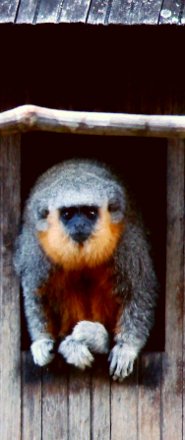 There is a lot biologists still need to learn about the red-bellied or dusky titi (Callicebus moloch) except for one thing – they mate for life. Dusky titis in captivity become frantic if they are ever separated from their mates. These small, South American monkeys mate for life. If lucky, that monogamous life can last 25 years.
There is a lot biologists still need to learn about the red-bellied or dusky titi (Callicebus moloch) except for one thing – they mate for life. Dusky titis in captivity become frantic if they are ever separated from their mates. These small, South American monkeys mate for life. If lucky, that monogamous life can last 25 years.Dusky titis are dependent on forests in order to survive. They are under threat because of deforestation in their native countries of Bolivia, Peru, Paraguay, Columbia, Brazil and Venezuela. They are hunted by humans for their meat and skins. Their natural predators are large birds of prey, including the Guianan crested eagle and the ornate hawk-eagle. Dusky titis spend the majority of their lives in trees, which removes them from ground-dwelling predators.
Physical Description
The dusky titi is a small monkey with a tail often as long as or even longer than the body length. Males tend to grow larger and heavier than females, although females sometimes grow longer tails than males do. Males grow a body length from 11.8 to 17.7 inches (30 to 45 cm) while their tails reach lengths of 15.35 inches to 19.68 inches (39 to 50cm). In contrast, females only grow to 11.4 to 16.5 inches (29 to 42 cm) with a tail length of 14 to 25.1 inches (36 to 64 cm).
Dusky titis have black skin, which shows in their ears, faces, genitals and hands. Their thick, bushy fur color varies from individual to individual. Monkeys can be a rusty red, orange red, squirrel grey or a combination of red and grey. Sometimes their belly, sideburns and inner limb fur is a brighter color than their backs or tails. Some other individuals sport only one color fur. Their eyes are usually brown.
Life Cycle and Behavior
Dusky titis primarily eat fruit, young leaves and buds, but will also eat spiders, insects and insect cocoons. Because of the low nutritional content of their diet, dusky titi monkeys need to spend 2 to 3 hours per day eating in order to survive. Monkeys sleep in nests made from vines wrapped up in tree branches. They wake at dawn and spend the next 12 hours in activity until finding another site for sleeping. Throughout the day, both males and females constantly call to each other.
Females give birth to a single baby after 128 to 133 days gestation. Females will eat more insects in this stage than they will at any other point in their lives. Both males and females help carry and protect the babies. Sometimes dusky titi families are attacked by other monkeys, such as the tufted capuchins, which rarely kill dusky titi monkeys but have been observed doing so. Usually, other monkey species chase smaller ones away from any food source they have discovered. Males and females spend a large part of the day grooming each other, which helps strengthen their bond.
Picture of the dusky titi by Ana Cotta, licensed under the Creative Commons Attribution 2.0 Generic license.
Keywords: red , tail , diurnal
Which zoos have them?
Smithsonian National Zoological Park (United States)The Dusky titi, red-bellied titi, titi monkey is listed as Least Concern. Does not qualify for a more at risk category. Widespread and abundant taxa are included in this category, on the IUCN Red List of Threatened Species
Countries
BrazilSome facts about the
Dusky titi
Adult weight : 0.804 kg (1.7688 lbs)
Maximum longevity : 26 years
Female maturity :912 days
Gestation : 163 days
Weaning : 244 days
Litter size : 1
Litters per year : 1
Interval between litters : 365 days
Weight at birth : 0.086 kg (0.1892 lbs)

Custom Search